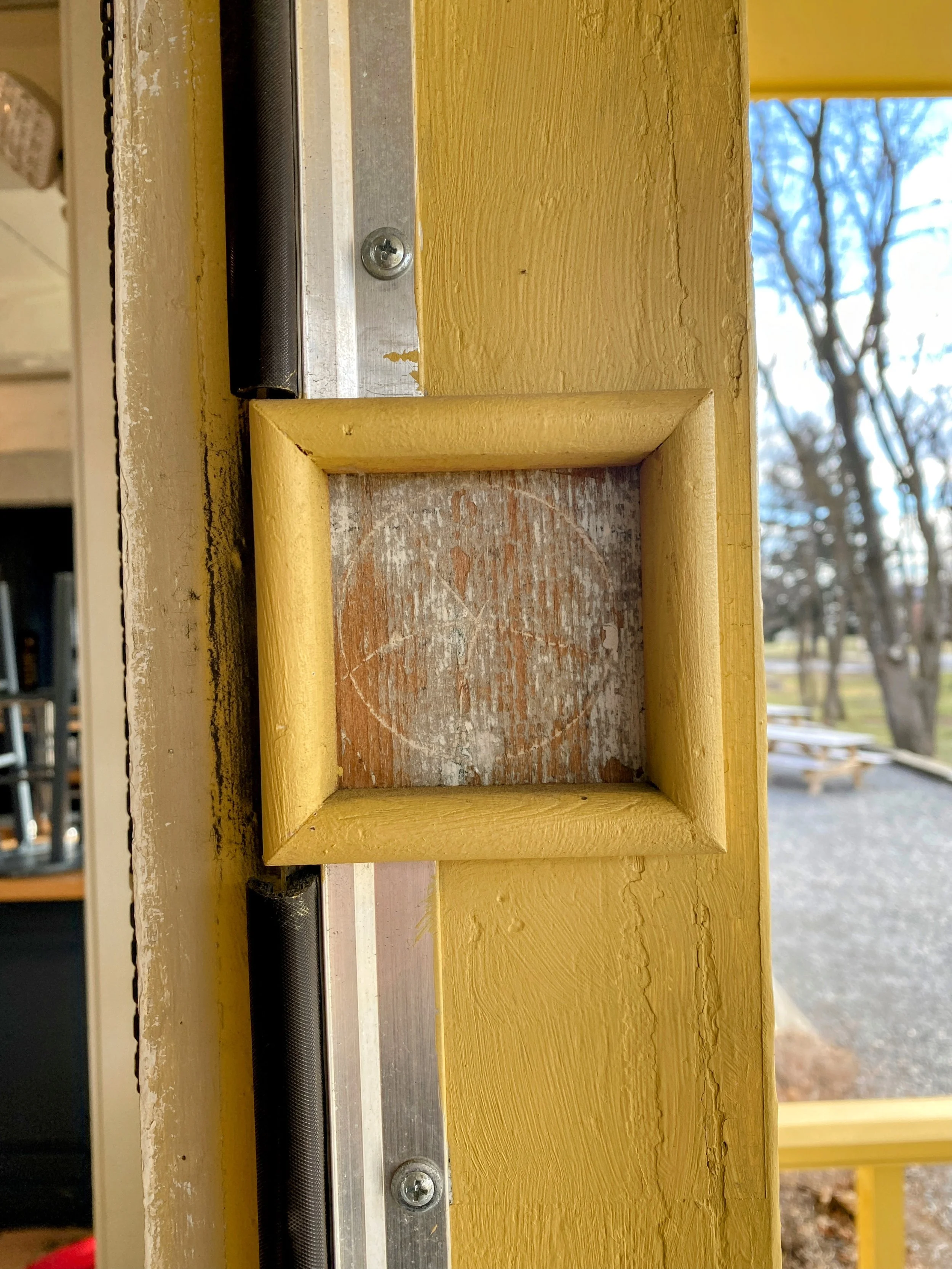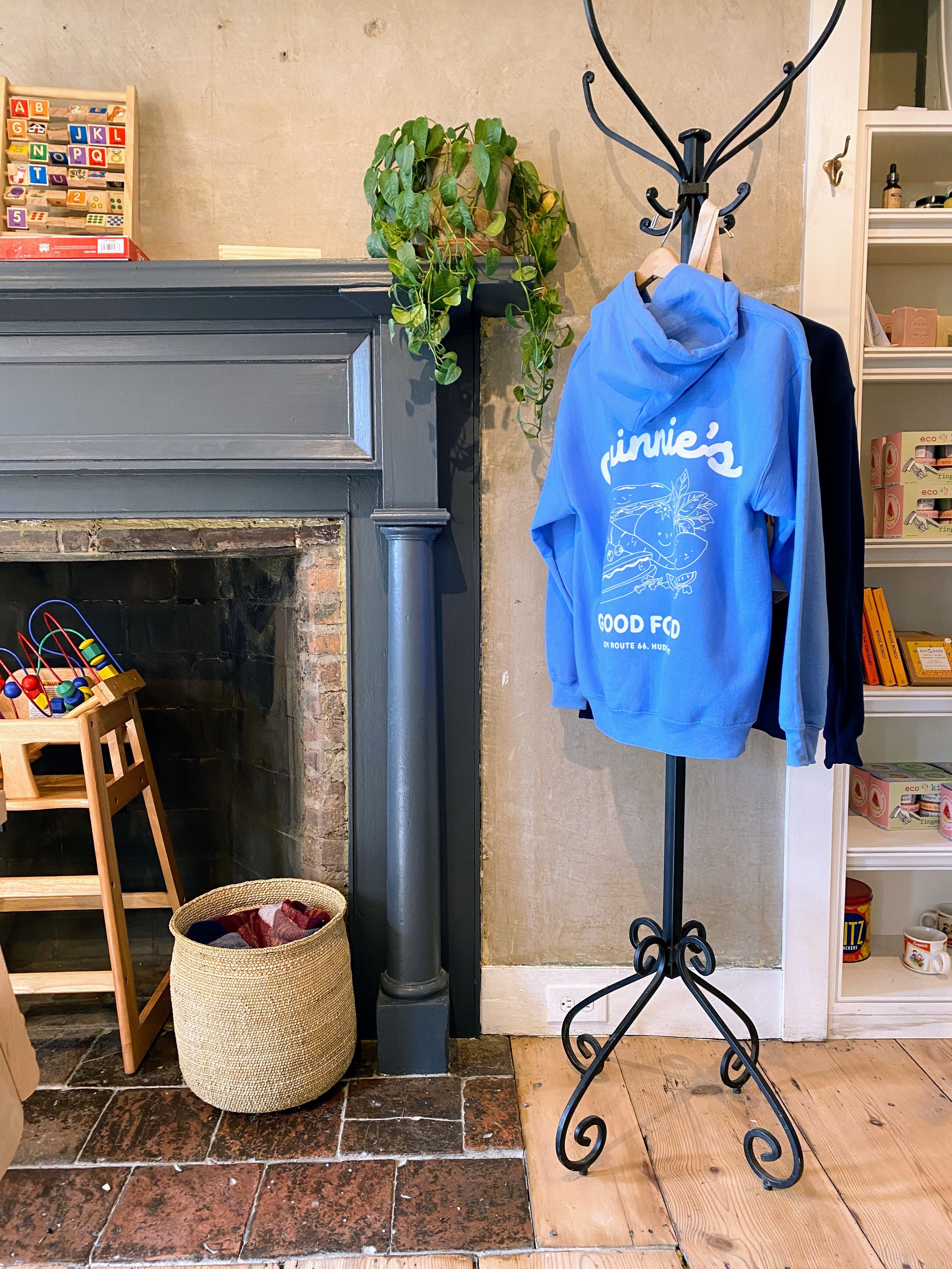Quinnie's: Good Food in a 250-Year-Old House
Simon Burstall and Quinn Levine pose on the restored front porch at Quinnie’s. via @quinniesnewyork on Instagram
The yellow house at the intersection of 9H and NY-66 in the Town of Claverack has stood as a local landmark for over 200 years. When Quinn Levine and Simon Burstall first saw the building in 2020, it had been vacant and on the market for more than six years. The land was thought to be more valuable without the house, and potential buyers wanted to demolish it. Thankfully, the former owner wanted to see the house saved — and Quinn and Simon saw possibility where others saw a liability. It was a long road for the couple to finally open Quinnie’s in late 2021, but according to Quinn, “it turned out exactly as it should have.”
After becoming parents, Quinn and Simon moved upstate from the city. When the couple landed in the Hudson Valley in 2018, they knew they wanted to build something of their own. Quinn had worked in restaurants for years and had run a successful wedding planning business. The idea for Quinnie’s had been growing as they became more a part of their new community, and the early days of the pandemic inspired them to make moves to turn that dream into a reality. Starting a new business is challenging under the best of circumstances, but Quinn and Simon’s journey was made even more difficult by zoning regulations — the house, despite being in a commercial district, had always been zoned as residential. The desire to adapt the house as a restaurant required months at zoning and planning board meetings. The pair closed on the house in July 2020, but the Town did not grant approval until November 2020, with a building permit further delayed until April 2021. And then the actual restoration began.
Before and after: The front facade, interior stairway and dining room; exterior side porch.
Simon, a photographer by trade, took the lead on the extensive renovation project. He had no former experience working on historic buildings, but threw himself completely into the project. He assembled a ragtag team to complete the work, including lead carpenter Andy Fennell. Everything needed work, including all new plumbing, electrical, and HVAC systems. The exterior of the building was painstakingly restored by hand — including the circa 1790 shutters that were all scraped, painted, and reinstalled by Simon — as were the original wood windows. Project architect Simon Arnold, AIA of Arnold Studio noted that “throughout the first floor, layers of wallpaper and paint were meticulously removed to reveal the original horsehair and plaster finish; this surface, which has not seen the light of day since the building was constructed, has been left as found, giving the space a unique character, imbued with the history of the period.” Despite the extent of work needed, the team was able to complete the renovation in time for a November 2021 opening, less than one year after receiving their building permit. Reflecting on the project, Andy Fennell said, “It was a privilege working on such a gem of a house. I feel grateful to be part of repurposing and preserving this house to ensure its future for the next generation.”
Details: The hex symbol uncovered and preserved in the doorway; Exposed wood support beams; an original door handle shaped like a bird; the menu board installed over an intact fireplace with historic tiling; restored 4over3 wood windows shine light on original wide plank wood floors; a second mantle in the dining area provides cover for a high chair and some toys for their young visitors; Simon, in the basement, sorting through historic finds from the renovation, including bits of ceramic and wallpaper; a disco ball hangs in the c.1948 garage, now used as extra dining space.
Walking through the space with Simon, it’s clear how much of himself he put into the project. It was arduous, but it was also deeply fulfilling. He noted how connected he felt to the space after spending so much time working on it, and how he likewise felt connected to the generations of people who inhabited the space before him. He was thrilled to show off a box of small treasures discovered during the renovation and the hex symbol carved into the doorway to ward off evil spirits. The team put so much care into maintaining as much historic fabric as they could, and really celebrated the fact that this property had such a rich history attached to it. When asked whether he considered himself a preservationist, Simon sort of came around the idea gradually. He wouldn’t have before tackling this project, but now, maybe he is. And truly, labels aside, great preservation work is done every day by folks who would never think of themselves as “preservationists.” The preservation success story of Quinnie’s is proof of that.
Once the renovation was winding down, it was time for Quinn to take the lead on building out the restaurant. Quinn and Simon both went into the project knowing they wanted to create a community space, somewhere all sorts of people would feel comfortable spending time. A place that was for single people, families with young children, and retirees alike. Quinn and Simon were building a business they felt would benefit their community, and the community seemed to respond in kind. Quinn noted that “once we started, it felt like people were carrying us.”
What was formerly a home is now a bustling restaurant, but one with a decidedly homey feel. It’s like going to eat at a good friend’s house, only the whole neighborhood is invited. With a focus on local goods and locally sourced ingredients, the menu reflects the community as well. And the land on which Quinnie’s sits (the asset that very likely otherwise would have led to its demolition in favor of a large-scale development), adds to the functionality as a community gathering place. There are outdoor tables and fire pits and open space for events. Plenty of possibilities for the restaurant to continue evolving to best serve its audience.
How can a historic building be an asset for its community if its original use is no longer feasible? Preservation, at its best, is about people just as much as it is about buildings. Quinn Levine and Simon Burstall saw an old, vacant building and knew it could become something really special. A place for them to realize their dreams and a place where they could welcome their community with open arms. Quinn recounted a scene she saw shortly after the restaurant opened where two dads and their kids were playing Scrabble in the dining room and she thought to herself, “This is it.”














